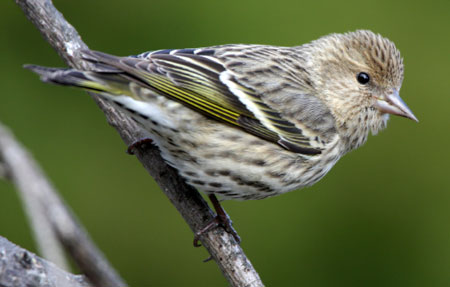Carduelis pinus
Mention the name and those familiar with this songbird conjure an image of this little acrobat hanging upside down in an evergreen tree picking seeds from a pine cone. The soundtrack to this mental movie contains the signature vocalization that indicates a Pine Siskin is nearby: a buzzy, raspy “zree-ee-e-e-e” that rises in pitch as it progresses.
If you are not familiar with the Pine Siskin you are in good company. For those of us in the eastern U.S., our opportunities to get acquainted are limited. Pine siskins breed across northern Canada and portions of Alaska, and south along the high elevations of the intermountain west. But the good news is that the Canadian population irrupts into the eastern states in winters when tree seed stocks are limited in their northern range. The trick is to find the rather nondescript finch among your winter-plumaged American Goldfinches!
Looks like a goldfinch but it’s too streaky? You may have found a siskin! The bill may seem too thin as well. A closer look should reveal pale yellow in the wing and tail feathers. Note this feature and you can check off another feeder bird identified in your backyard. This yellow may be most apparent when the bird takes flight.
The thinner bill of the Siskin limits its seed diet to fine textured seeds, even more so than redpolls, goldfinches, and Purple Finches. They relish the ingredients used in Aspen Song® Finch mix: nyjer seed, small yellow millet, canary seed, canola, and fine pieces of sunflower kernels. Tube feeders with tiny seed openings, generally called finch or nyjer tubes, dispense food to the finches with minimal waste.
Natural food choices of the Pine Siskin include the seeds of various grasses and native plants. They will also consume the seeds of conifer and deciduous trees varieties that have small seeds and tender buds. At such times they utilize their acrobatic skills to hang, cling, stretch their way to a food source.
When you have spotted one Pine Siskin, there are usually others present. Visually scan the yard for more. In the winter they join foraging flocks of goldfinches and redpolls. If you have groups of finches visiting your winter feeders regularly, it is a good idea to keep an eye out for this interesting visitor from the north.
Reference
Dawson, William R. 1997. Pine Siskin (Carduelis pinus), The Birds of North America Online (A. Poole, Ed.). Ithaca: Cornell Lab of Ornithology.
